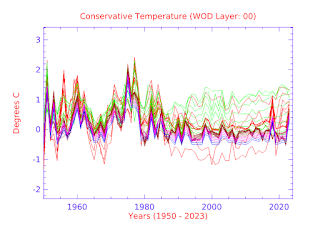 |
| Fig. 1 WOD Layers |
Temperature is not the only player in the photon current in the oceans, we should also consider salinity change.
Ocean temperature change can cause ocean salinity change (Detection and attribution of Atlantic salinity changes,).
The better way to analyze this is to use TEOS-10 techniques:
"In situ ocean salinity observations are sourced from the World Ocean Database (WOD) downloaded in July 2018 (Boyer et al. 2018), with its quality flags being used to remove spurious data. Data from
all available instruments (i.e., Argo, Bottle, CTD) are used in this study. Although salinities are archived in units of Practical Salinity (PSS-78, or psu), Absolute Salinity (SA; g kg−1) is adopted in this study as recommended in the Thermodynamic Equation of Seawater–2010 (TEOS-10) (McDougall et al. 2012)."
(Improved Estimates of Changes in Upper Ocean Salinity and the Hydrological Cycle).
This analysis has to be considered because salt can absorb 'heat' in the form of IR photons:
"A solar power plant in Spain uses salt to store solar energy:
'Near Granada, Spain, more than 28,000 metric tons of salt is now coursing through pipes at the Andasol 1 power plant. That salt will be used to solve a pressing if obvious problem for solar power: What do you do when the sun is not shining and at night?
The answer: store sunlight as heat energy for such a rainy day ... salts ... can be used to store a lot of the sun's energy as heat.'
(Scientific American, How to Use Solar Energy at Night)."
Thus the question arises: "when IR photons are absorbed by atoms in seawater are they absorbed by the atoms in water or the atoms in salt or either one (atoms in water and salt can absorb photons)?".
In previous posts of this series I pointed out that the obvious direction for photons to travel through the vast majority of ocean locations is downward, following the 2nd law of thermodynamics.
While analyzing data I noticed that some of the deeper depths (e.g. 4000-5000+ meter) range showed signs of warming.
I also wondered why this wasn't being noticed in the majority of papers dealing with this issue (not including those that only skim the surface down to about 2000 meters).
While pondering the perplexing problem I noticed that the WOD manual indicates maximum and minimum values for the temperature and salinity of various oceans (WOD manual 2013, Appendix 11.1 - 11.2, p. 132-137).
I decided to check out their temperature assertions for depths where the 'minimum' temperature was below zero degrees Celsius.
I used the TEOS-10 C++ library function 'gsw_ct_freezing' to determine that some of their minimum values are below the freezing point, thus, some valid in situ measurements (above that freezing point) are sure to be rejected (note that the first paper cited above indicated that "with its quality flags being used to remove spurious data").
Some of the 'spurious data' was valid.
II. The New Quality Tests
So, I used the WOD estimates for maximum and minimum values for various oceans as a benchmark for rewriting software that was analyzing the WOD data layer by layer.
Today's post has graphs that used that TEOS-10 based revision of the same WOD data that had been used to generate previous graphs.
The differences are colorful, but the exact same number of layers and WOD zones are used.
The number of lines in each depth span is the same too.
III. What Has Changed?
I used the TEOS-10 C++ library function 'gsw_ct_freezing' to determine the Conservative Temperature (McDougal et al. 2023) at which the seawater would freeze.
If the WOD manual minimum was at or below that value, I changed the minimum to that value, and the maximum to that value plus the span between them (the span between them remained the same quantity, the same number of iterations).
What this indicates is that to some degree the warming of the oceans was accidentally covered up by the exclusion of research values below the freezing point, but it does that by only allowing 'through the gate' those in situ measurements in the WOD database which were at or lower than the maximum recorded temperature and were at the manual's minimum temperature or higher.
In other words, the only thing that changed was which in situ temperature values were included in calculating the average and making the graphs.
But the minimums were no longer the few imaginary values that could not exist in seawater because at the freezing point seawater loses fresh water and becomes seabrine (the amounts of each depending on the degrees below the freezing point).
IV. Comparisons And Closing Comments
Today's appendices (Appendix WOD NFD-1, Appendix WOD NFD-2, Appendix WOD NFD-3) can be compared to those in the previous post (Appendix WOD D-1, Appendix WOD D-2, Appendix WOD D-3).
As you can see, the lower level warming taking place was excluded by the quality control values in the decade-old WOD - 2013 manual (which essentially the same in the 2018 version).
The next post in this series is here, the previous post in this series is here.
It is said that a photon is a boson ...




































